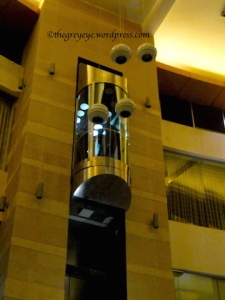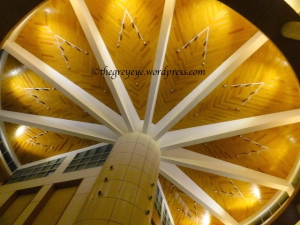I was lucky to be invited as a guest speaker in the conference of SAARC countries, which held this year in Dhaka, the capital of Bangladesh. At first I was not sure if I will be able to make upto it, but I am so happy that I did. Dhaka Metropoliton area is the 11th largest city area in the world and home to 14 million people. It is an old city rich in culture and history, and the birthplace of world famous fabric “muslin” .
The whole conference was arranged by armed force, so everything was extremely regulated. We reached on Hajarat Shah Jalal international airport early in the morning and already Army Captain Sadat was waiting for us. He took us to the Kuprmitola Golf club guest house, one of the greenest area of Dhaka, where our stay was pre-booked. And here are the pictures of my room 🙂
Dhaka has many golf clubs, but this one considered to be the best. And I totally agree. The club is run by the chief of Bangladesh army himself. The course is strategically challenging and playable round the year with an area of 126 acres laid out for professional golf. I loved it because of the soothing green all around. In the maddening crowd of Dhaka, it is really a visual treat and heavenly experience.. The staff are extremely friendly and helpful. You would really feel at home by their warm and hearty welcome, which is hard to find in western world. I must mention of Arif, a boy working in the hotel to support his studies and was kind enough to take care of every guest.
The hotel staff took us for shopping to their best shopping mall Jamuna future park. The mall is the largest of its type in South Asia, and also the 11th largest in the world with a total area of 5,450,000 square feet. The complex is spread across 33 acres of land in Kuril, Baridhara, situated on the Pragati Sharani, neighboring posh residential areas of Dhaka city like Gulshan, Banani, and Bashundhara.
Next day, I had my lecture in the post lunch academic session. I arrived and listened to other lectures while I met the Professor & HOD ,from Dhaka Medical College. She was so kind to give us her car accompanied by two lovely lady lecturers from her department. They took us to the Shaheed Minar, or the Martyr’s monument, located near Dhaka Medical College remembering those who lost their life during the protests on 21 February 1952. Now, if one thing I wanted to see in dhaka was this monument. The language movement in pre-indipendence from Pakistan is an important movement in the history of the subcontinent and significant to all people world over who love their mother tongue.
In 1948, the Government of the Dominion of Pakistan ordained Urdu as the sole national language, sparking extensive protests among the Bengali-speaking majority of East Bengal. The government even outlawed public meetings and rallies. The students of the University of Dhaka and other political activists defied the law and organised a protest on 21 February 1952. During the movement ” ভাষা আন্দোলন” police killed student demonstrators on that day. The deaths provoked widespread civil unrest. After years of conflict, the central government relented and granted official status to the Bengali language in 1956. In 1999, UNESCO declared 21 February as International Mother Language Day, in tribute to the Language Movement and the ethno-linguistic rights of people around the world. Even today, there is a big celebration to recognise the victory of “Bangla language “on each February and to salut the students who laid their lives during the movement. It is still a place of great emotion and pride for 300 million native speakers of the language “বাংলা” .
Our next stop was Dhakeshwari National Temple, a Hindu temple, seat of the goddess of Dhaka. There is one school of thought that the name of the city has been derived from the name of the goddess. The original 800-year old statue was taken to India. There remains the replica of original idol in Dhaka, which is beautiful as you can see. The temple was severely damaged during the 1971 Bangladesh Liberation War and damaged further during the Muslim mob attacks of 1989–90, and over half of the temple’s buildings were destroyed. The main worship hall was taken over by the Pakistan Army and used as an ammunitions storage area. Several of the temple custodians were tortured and killed by them .
A significant portion of the temple land has been lost due to the Vested Property Act and confiscation by the Bangladesh Government, and the current premises are considerably lower than the historic reach of the property. Muslim mobs have attacked the temple complex many times, with the last major attack taking place in December 1992, following the demolition of Babri Masjid in India.
The people there were so nice that they gave us “Prosad” (meaning the sweets /edible foods first offered to a deity and then after her blessings given to the worshippers) as they heard we came from another country to see the goddess.
Then we visited the Aparajeyo Bangla ( অপরাজেয় বাংলা) , one of the most well known sculptures dedicated to the Bangladesh Liberation War, located in the campus of Dhaka University. The phrase means “Unvanquished Bengal”
On way back we saw Doel chattor, a common road junction in Dhaka, after the name of their national bird. We also saw the “Three leaders Mausoleum” , a monument having burial of three pre -liberation political leader. But I could not take the photo. So, here is one from google



Being satisfied with our short trip, I came back to the conference hall and delivered my talk. During the sessions I found little funny though, that most of the delegate ladies were busy uploading photos in Facebook and they talked about shopping and shopping. Most of them did not even plan to visit any of the heritages of this great old city. After the academics finished, they took us to the hotel and after some refreshment we were provided a car to reach the dinner venue. The same venue was hosting the marriage anniversary of Bangladesh Cricket Team Captain, so we met some celebrity as well 😛 .
We had an wonderful dinner with some local delicacies. I am sorry I could not click the photos of awesome Bengali cuisine, because my colleague would have thought I am too crazy 😛 .
Next day after heavy academic discussion, we had a nice lunch followed by the famous Bengali desert, ” Rosogolla & mist doi” . I had my evening flight, so I needed to pack up. But as the Prime minister of Bangladesh was coming to chair the evening session, all roads were closed. Our organising secretary, Brig General, arranged a VVIP road pass for us and we reached airport on time through a path, even not seen by most of their countrymen. I am so overwhelmed by their warmest welcome, mouthwatering cuisine, rich culture and academic extravaganza, that I am definitely going back to Dhaka in future 😀
And I hope my readers enjoyed this entirely different South asian treat !!
[References: wikipedia].
© thegreyeye.wordpress.com, 2015-21. Unauthorized use and/or duplication of this material without express and written permission from this blog’s author and/or owner is strictly prohibited. All rights reserved.

























































Wonderful photographs and insight into another culture – I know very little of Bangladesh, and your photos are in stark contrast to the ones that my daughter took in India.
I was very interested t read about the banning then reinstatement of the Bangladeshi language, this is very similar to what happened in Wales in the early 20th century, were Welsh was banned and people forced to speak English and children punished in schools for speaking their own language, this has changed now and all is in Welsh first and English second.
Nice cultural observation of the ladies uploading photos to face book during the conference.
So sad that people feel the need to destroy the places of worship of others…….
LikeLiked by 2 people
Thank you Lindy for reading the whole story. It is all together a life enriching experience for me
LikeLike
I always read the whole story, I don’t just look at the pictures or hit the ‘like’ button, I am sure others do too. It is always very interesting what you write . : )
LikeLiked by 2 people
thank you, that is a great complement.. 🙂
LikeLiked by 1 person
The photos, the description everything is so well presented
LikeLiked by 1 person
Interesting post with good px.
LikeLiked by 1 person
Thank you for reading it. It is an unique experience for me indeed
LikeLike
I very much enjoyed reading your post. It is so very interesting.
LikeLiked by 1 person
It is completely different from Europe, and I enjoyed the trip and their hospitality very much
LikeLike
Thanks for sharing this.
LikeLiked by 1 person
Thank you too Maremma, for reading 🙂
LikeLike
Wow, this was so interesting! When I was in school, Bangladesh was, unfortunately, our go-to example of a country affected by extreme poverty. Your experiences during your visit tell a very different story – they must have made some incredible leaps forward!
LikeLiked by 1 person
Irony is most of the Indian subcontinent was far richer than the western world until British occupied them, cut the hands of muslin makers, forced people to buy their synthetic products, force the farmers to cultivate Indigo, instead of peddy or wheat, and destroyed the whole economy of these countries. Now, the rich became 3rd world countries and the aggresors give example of their poverty.
LikeLiked by 3 people
Good point… Colonialism really has a lot to answer for. A huge chunk of the world is still recovering from that period of history, and it seems like the end is a long way off yet…
LikeLiked by 1 person
Yes you are right. And may be the common people did not even know, what their politicians are doing . Many of them even oppose, but they do not have the power to combat it always.
LikeLiked by 1 person
Wow! Even after all the past conflicts and destruction, it’s appears the “recovery” has been great! Thank you for your insight, and thank you for sharing! Beautiful place!
LikeLiked by 1 person
Thank you for reading
LikeLike
Very informative post! We love rasgulla and mishit dhoi here in Mumbai too !
LikeLiked by 1 person
I love it too
LikeLiked by 1 person
Wow. I never would have expected Dhaka to be like this, golf course and all. Thanks for the insight.
LikeLiked by 1 person
I didn’t know that too, it is a nice experience for me as well
LikeLike
Thank you for opening doors onto a different culture.
LikeLiked by 1 person
Thank you for reading it
LikeLiked by 1 person
Very interesting! nice work 🙂
LikeLiked by 1 person
Thank you
LikeLike
Beautiful pictures…
LikeLiked by 1 person
Thank you nimi 😄
LikeLiked by 1 person